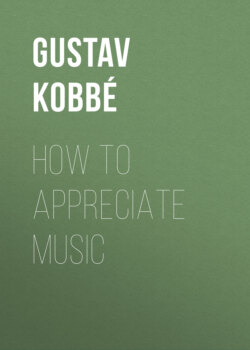Читать книгу How to Appreciate Music - Gustav Kobbé - Страница 7
На сайте Литреса книга снята с продажи.
Music’s Debt to the Pianoforte.
ОглавлениеIt would be difficult to overestimate the debt that music owes to the pianoforte. Including for the present under this one name the various keyboard instruments from which it was developed, the sonata form had its first tentative beginnings upon it and was wrought out to perfection through it by a process of gradual evolution extending from Domenico Scarlatti through Bach’s son, Philipp Emanuel Bach, to Beethoven. As a symphony simply is a sonata for orchestra, 36 it follows that through the sonata and thus through the pianoforte the form in which the classical composers cast their greatest works was established. Richard Strauss, in his revision of Berlioz’s book on orchestration, even goes so far as to assert that Beethoven, and after him Schumann and Brahms, treated the orchestra pianistically; but the discussion of this point is better deferred until we take up the orchestra and orchestral music.
Here, however, it may be observed that in addition to its constant use as an instrument for the concert hall and the home, and for the delight of great audiences and the joy of the amateur player and his familiar circle, many of the great composers, even when writing orchestral works, have used the pianoforte for their first sketches, testing their harmonies on it, and often, no doubt, while groping over the keys in search of the psychical note, hit upon accidental improvements and new harmonies. Even Wagner, who understood the orchestra as none other ever has, employed the pianoforte in sketching out his ideas. “I went to my Erard and wrote out the passage as rapidly as if I had it by heart,” he writes from Venice to Mathilde Wesendonck, in relating to her the genesis of the great love duet in “Tristan und Isolde,” and I could quote other passages from my “Wagner and his Isolde,” which is based on the romantic passages in the lives of the composer and the woman who inspired his great music-drama, to show the frequency with which he made similar use of the universal musical instrument.
The pianoforte has in many other ways been a boon to some of the most famous composers. Many of them 37 were pianists, and by public performances of their own works materially accelerated the appreciation of their music. Mozart was a youthful prodigy, and later a virtuoso of the highest rank. Beethoven, before he was overtaken by deafness, introduced his own pianoforte compositions to the public and was the musical lion of the Viennese drawing-rooms. Mendelssohn was a pianist of the same smooth, affable, gentlemanly type as his music. Chopin was not a miscellaneous concert player—his nature was too shrinking; but at the Salon Pleyel in Paris he gave recitals to the musical élite, who in turn conveyed his ideas to the greater public. Schumann began his musical career as a virtuoso, but strained the fourth finger of his right hand in using a mechanical apparatus which he had devised for facilitating the practice of finger exercises. His wife, Clara Wieck, however, who was the most famous woman pianist of her time, substituted her fingers for his. Liszt literally hewed out the way for his works on the keyboard. Brahms was a pianist of solid, scholarly attainments. In fact, dig where you will in musical soil, you strike the roots of the pianoforte.
